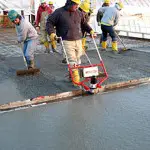Vibration of concrete is carried out for the sake of consolidation. The main objective of vibration is to compact the concrete and to achieve the maximum possible density of concrete. Almost 5 to 8% by volume of freshly placed concrete in the form is occupied by air bubbles. Air bubbles occupy this space in a high workable concrete mix.
Air bubbles can be removed by decreasing in the amount of required water, but it affects workability of concrete. Therefore, vibration of concrete is the only suitable method that helps without affecting much the properties of fresh concrete. Vibration is only affected in a fresh mix concrete or one can say up to that time, when concrete has the ability to flow. This stage exists before the starts of initial setting.
Vibration reduces the internal friction by randomizing concrete. This able the concrete to rearrange the particles (these particles include coarse aggregates and fine aggregates). When rearrangement of particles occur than a close configuration of coarse aggregate is achieved. Close packing expels most of the entrapped air in between, but still some air bubbles left. 100% air bubbles are difficult to remove from concrete.
During the vibration of concrete, site engineer should ensure that vibration is applied to the entire mass of concrete uniformly. This is so, because if not applied uniformly than some volume of concrete get fully compact and some parts remain un-compacted. Site engineer should also strictly follow the vibration time period, because over vibration of concrete cause segregation and bleeding of concrete. Therefore, proper consistency is required during the vibration.
Concrete Vibrators
There are many of concrete vibrators. Some vibrators vibrate concrete internally and there are also many vibrators that vibrate the concrete externally. Vibrators can be classified as;
- Internal vibrators
- External vibrators
- Vibrating tables

Excellent article. I certainly appreciate this site. Stick
with it!